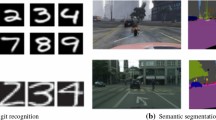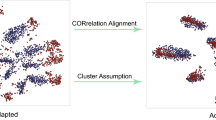Abstract
Transfer learning aims to help target learners with a different but related source domain. Open set recognition extends the settings of transfer learning for identifying whether an instance belongs to an unseen category. However, it is often pragmatic and valuable to further classify the unseen categories in target domain. We present a new setting called open set broad classification (OSBC) to classify unseen target categories which are open within the broad classes of source domain. Aiming at adapting to the challenging domain shift between unseen categories and seen categories, we propose a variational autoencoders model with coarse-and-fine alignment (CFVA) to leverage the structural information in the OSBC setting. First, two-stream decoders are employed and coarsely aligned by a relaxed parameters regularizer, which can absorb domain shift on features to facilitate fine alignment. Then fine alignment at encoding level enhances discriminative power of the latent representation by mixing the distributional structure hinted by source domain. Experimental results demonstrate the effectiveness of our CFVA approach in improving the accuracies in both unsupervised and semi-supervised cases.







Similar content being viewed by others
Availability of data and materials
The datasets generated during and/or analysed during the current study are available in the cifar-100 repository, http://www.cs.toronto.edu/~kriz/cifar.html.
References
Scheirer WJ, Jain LP, Boult TE (2014) Probability models for open set recognition. IEEE Trans Pattern Anal Mach Intell 36(11):2317–2324
Busto PP, Iqbal A, Gall J (2020) Open set domain adaptation for image and action recognition. IEEE Trans Pattern Anal Mach Intell 42(2):413–429
Pan SJ, Tsang IW, Kwok JT, Yang Q (2011) Domain adaptation via transfer component analysis. IEEE Trans Neural Netw 22(2):199–210
Zhuang F, Cheng X, Luo P, Pan SJ, He Q (2017) Supervised representation learning with double encoding-layer autoencoder for transfer learning. ACM Trans Intell Syst Technol 9(2):16
Sun S, Liu H, Meng J, Chen CLP, Yang Y (2018) Substructural regularization with data-sensitive granularity for sequence transfer learning. IEEE Trans Neural Netw Learn Syst 29(6):2545–2557
Cevikalp H, Saglamlar H (2021) Polyhedral conic classifiers for computer vision applications and open set recognition. IEEE Trans Pattern Anal Mach Intell 43(2):608–622
Geng C, Tao L, Chen S (2020) Guided CNN for generalized zero-shot and open-set recognition using visual and semantic prototypes. Pattern Recognit 263:102–107
Wang W, Zheng VW, Yu H, Miao C (2019) A survey of zero-shot learning: settings, methods, and applications. ACM Trans Intell Syst Technol 10(2):13–11337
Wang C, Chen X, Min S, Sun X, Li H (2021) Task-independent knowledge makes for transferable representations for generalized zero-shot learning. In: Thirty-fifth AAAI conference on artificial intelligence (AAAI), pp 2710–2718
Ge J, Xie H, Min S, Zhang Y (2021) Semantic-guided reinforced region embedding for generalized zero-shot learning. In: Thirty-fifth AAAI conference on artificial intelligence (AAAI), pp 1406–1414
Luo Y, Wang X, Pourpanah F (2021) Dual vaegan: a generative model for generalized zero-shot learning. Appl Soft Comput 107:107352
Blitzer J, Kakade SM, Foster DP (2011) Domain adaptation with coupled subspaces. In: Proceedings of the fourteenth international conference on artificial intelligence and statistics. pp 173–181
Wang W, Pan SJ (2018) Recursive neural structural correspondence network for cross-domain aspect and opinion co-extraction. In: Proceedings of the 56th annual meeting of the association for computational linguistics (ACL), pp 2171–2181
Fernando B, Habrard A, Sebban M, Tuytelaars T (2013) Unsupervised visual domain adaptation using subspace alignment. In: Proceedings of the IEEE international conference on computer vision (ICCV), pp 2960–2967
Ding Z, Fu Y (2017) Robust transfer metric learning for image classification. IEEE Trans Image Process 26(2):660–670
Sun B, Feng J, Saenko K (2016) Return of frustratingly easy domain adaptation. In: Proceedings of the thirtieth AAAI conference on artificial intelligence (AAAI), pp 2058–2065
Chen Y, Song S, Li S, Wu C (2020) A graph embedding framework for maximum mean discrepancy-based domain adaptation algorithms. IEEE Trans Image Process 29:199–213
Ganapathiraman V, Shi Z, Zhang X, Yu Y (2018) Inductive two-layer modeling with parametric bregman transfer. In: Proceedings of the 35th international conference on machine learning (ICML), pp 1622–1631
Zhang L, Liu J, Yang Y, Huang F, Nie F, Zhang D (2020) Optimal projection guided transfer hashing for image retrieval. IEEE Trans Circuits Syst Video Technol 30(10):3788–3802
Roy J, Konidaris GD (2021) Visual transfer for reinforcement learning via wasserstein domain confusion. In: Thirty-Fifth AAAI conference on artificial intelligence (AAAI), pp 9454–9462
Courty N, Flamary R, Tuia D, Rakotomamonjy A (2017) Optimal transport for domain adaptation. IEEE Trans Pattern Anal Mach Intell 39(9):1853–1865
Long M, Wang J, Cao Y, Sun J (2016) Deep learning of transferable representation for scalable domain adaptation. IEEE Trans Knowl Data Eng 28(8):2027–2040
Long M, Cao Y, Cao Z, Wang J, Jordan MI (2019) Transferable representation learning with deep adaptation networks. IEEE Trans Pattern Anal Mach Intell 41(12):3071–3085
Qian K, Zhang Y, Chang S, Yang X, Hasegawa-Johnson M (2019) Autovc: zero-shot voice style transfer with only autoencoder loss. In: Proceedings of the 36th international conference on machine learning (ICML), pp 5210–5219
Rozantsev A, Salzmann M, Fua P (2019) Beyond sharing weights for deep domain adaptation. IEEE Trans Pattern Anal Mach Intell 41(4):801–814
Heinze-Deml C, Meinshausen N (2021) Conditional variance penalties and domain shift robustness. Mach Learn 110(2):303–348
Wang J, Cheng M-M, Jiang J (2021) Domain shift preservation for zero-shot domain adaptation. IEEE Trans Image Process 30:5505–5517
Kamath A, Jia R, Liang P (2020) Selective question answering under domain shift. In: Proceedings of the 58th annual meeting of the association for computational linguistics. pp 5684–5696
Wang C, Sennrich R (2020) On exposure bias, hallucination and domain shift in neural machine translation. In: Proceedings of the 58th annual meeting of the association for computational linguistics (ACL), pp 3544–3552
Kalogeiton V, Ferrari V, Schmid C (2016) Analysing domain shift factors between videos and images for object detection. IEEE Trans Pattern Anal Mach Intell 38(11):2327–2334
Daume III H (2007) Frustratingly easy domain adaptation. In: Proceedings of the 45th annual meeting of the association for computational linguistics (ACL), pp 256–263
Qiu Q, Chellappa R (2015) Compositional dictionaries for domain adaptive face recognition. IEEE Trans Image Process 24(12):5152–5165
Rozantsev A, Salzmann M, Fua P ( 2018) Residual parameter transfer for deep domain adaptation. In: IEEE conference on computer vision and pattern recognition (CVPR), pp 4339–4348
Cao A, Luo Y, Klabjan D (2021) Open-set recognition with gaussian mixture variational autoencoders. In: Thirty-fifth AAAI conference on artificial intelligence (AAAI), pp 6877–6884
Ben-David S, Blitzer J, Crammer K, Kulesza A, Pereira F, Vaughan JW (2010) A theory of learning from different domains. Mach Learn 79(1–2):151–175
Ganin Y, Lempitsky VS ( 2015) Unsupervised domain adaptation by backpropagation. In: Proceedings of the 32nd international conference on machine learning (ICML), pp 1180–1189
Chidlovskii B, Clinchant S, Csurka G (2016) Domain adaptation in the absence of source domain data. In: Proceedings of the 22nd ACM international conference on knowledge discovery and data mining (SIGKDD), pp 451–460
Dev K, Ashraf Z, Muhuri PK, Kumar S (2022) Deep autoencoder based domain adaptation for transfer learning. Multimed Tools Appl 81(16):22379–22405
Na J, Han D, Chang HJ, Hwang W (2022) Contrastive vicinal space for unsupervised domain adaptation. In: 17th European conference on computer vision (ECCV), pp 92–110
Pu Y, Gan Z, Henao R, Yuan X, Li C, Stevens A, Carin L (2016) Variational autoencoder for deep learning of images, labels and captions. In: Advances in neural information processing systems (NIPS), pp 2352–2360
Acknowledgements
This work was supported by the National Natural Science Foundation of China (Grant nos. 61876031).
Funding
This work was supported by the National Natural Science Foundation of China (Grant nos. 61876031).
Author information
Authors and Affiliations
Corresponding author
Ethics declarations
Conflict of interest
Not applicable.
Additional information
Publisher's Note
Springer Nature remains neutral with regard to jurisdictional claims in published maps and institutional affiliations.
Rights and permissions
Springer Nature or its licensor (e.g. a society or other partner) holds exclusive rights to this article under a publishing agreement with the author(s) or other rightsholder(s); author self-archiving of the accepted manuscript version of this article is solely governed by the terms of such publishing agreement and applicable law.
About this article
Cite this article
Sun, S., Huang, Y., Zhao, D. et al. Transferring variational autoencoders with coarse-and-fine alignment for open set broad classification. Int. J. Mach. Learn. & Cyber. 14, 3655–3669 (2023). https://doi.org/10.1007/s13042-023-01856-z
Received:
Accepted:
Published:
Issue Date:
DOI: https://doi.org/10.1007/s13042-023-01856-z




